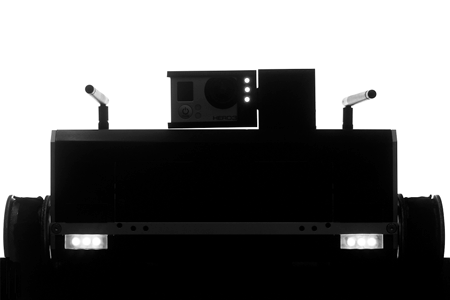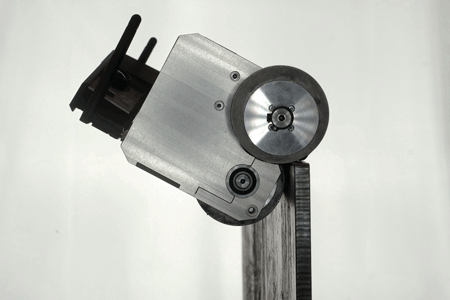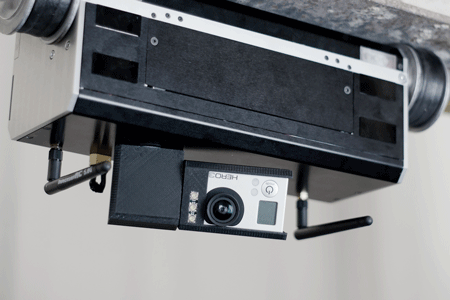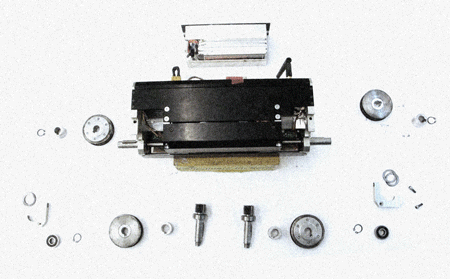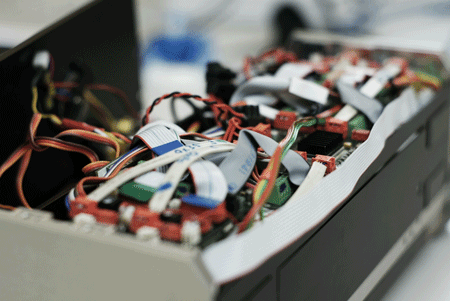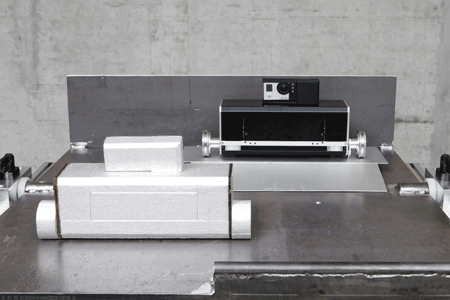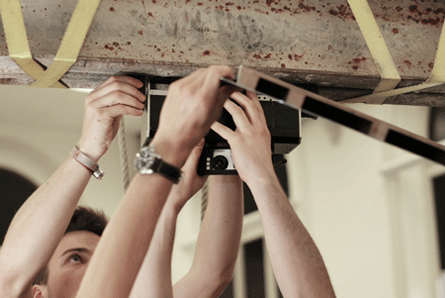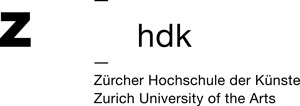a combination of mechatronics and design
SIR combines a compact attractive design with an innovative mechanical structure and a lightweight yet powerful electronic equipment.
Four strong, actuated magnetic wheels with a revolutionary alignment allow SIR to overcome the different profiles found in ship hulls and climb the ship structure independently of gravity.
An innovative detachment mechanism, which got patented, supports SIR to pass concave edges reliably.
Equiped with a paning camera and different sensors, SIR can be controlled remotely via radio connection. SIR provides a lot of feedback data for effective navigation and inspection.
Regarding the visual design, the values reliable, simple, compact and visual inspection come to mind.
Learn more about the design of the robot in the following sections:
SIR's dedication to mobility
Ship Inspection Robot comes with a revolutionary alignment of its magnetic wheels: The overlapping wheelbase enables SIR to climb a broad variety of steel profiles that occur in bulk carriers. Among them are concave and convex edges as well as L-, T-, and even I-shaped beams. Where conventional robots get stuck, Ship Inspection Robot enlarges the range of mobility.
Moreover, SIR's wheelbase allows it to turn-on-spot without the need of a steering fork. Navigation in narrow ship compartments is no longer an issue.
Together with other heavy components like the battery, SIR's drivetrain is assembled just above the robot's base. This tight packaging reduces the distance between SIR's centre of gravity and the ground to a minimum and thus increases SIR's climbing behaviour.
a patentworthy detachment mechanism
For detaching the magnetic wheels in a concave 90° edge, a new mechanism was designed. It is simpler, less susceptible to dirt and more reliable than existing solutions.
When driving through a concave edge with a magnetic wheel, it will get attached to two points at the same time: one on the first and one on the second plane. To continue the ride on the second plane, the magnetic force between the first plane and the wheel has to be overcome. This is prevented by a lever, which is mounted to the housing next to the wheel. The lever passively transmits the resulting force from driving against the second plane to the first one. Thus the wheel detaches from the first plane.
The lever is an innovative solution for this kind of problem. It is very simple and robust. Compared to the existing solution dirt affects the functionality much less and the problem of friction while driving does not occur anymore. Therefore, Alstom applied the lever detachment mechanism for patenting at the European patent office.
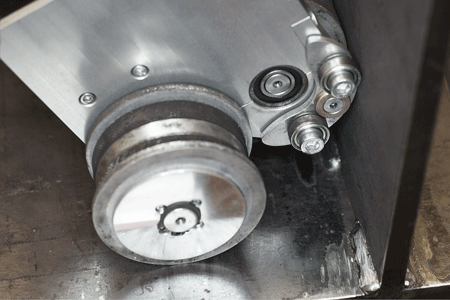
eyes and ears - the robot's sensors
The camera used on the robot is a GoPro Hero 3 where it serves as a demonstrator for a visual sensor. It is assisted by three lights, one pointing in the viewing direction while the other two illuminate the ground in a flat angle, so as to make bumps and small edges more visible thanks to the longer shadow they cast on the ground.
The robot uses four infra-red distance sensors for edge and obstacle detection, and an inertial measurement unit provides the operator with orientation data. These sensors are currently only used for user feedback.
Autonomous operations are not supported as of yet. Although not impossible to implement, we hope that direct control of the robot increases confidence in the handling and ultimately in the results.
a handy prototype
SIR's user friendliness is guaranteed by easily swappable wheels, a quickly exchangeable battery and a detachable electronics box.
The wheel hub connection was designed in a way that allows a simple detachment and exchange of the wheels. Therefore, different magnetic wheels can be tested on the prototype robot.
The robot design was planned modular in terms of electronics and mechanics as their assembly and maintenance often happen simultaneously. A deep-seated framework holds the drive-train while the overlying electronic box can be easily detached from the basic structure. Furthermore, the battery can be replaced in a few simple steps or the whole robot can be changed to wired connection.
remote inspection has never been easier
To fulfill its task, SIR is remote-controlled from a base station. There, the operator uses a common gamepad to control all of the robot's functions. He can monitor, other than the live video feed of the camera, the current speed and orientation of the robot, the battery usage and so on to have a complete overview of what is happening.
The wireless connection itself is robust and far reaching; it allows SIR to be savely and precisely controlled even in the furthest edges of a ship-hull with the help of four sophisticated motor controllers by AIR. A fifth processor-unit monitors all sensors, controlls the camera tower and the illumination of the environment.
As a power source for SIR, an RC battery is used. It allows for about three hours of non-stop inspection and can be fully recharged in under 30 minutes. If desired, SIR can also be operated via cabled connections.
a presentable and trustworthy design
SIR persuades its customer with an integral design that was achieved through a close collaboration between mechanical, electrical and industrial design engineers.
Key items from the design are represented by SIR's appearance: reliability, simplicity, compactness as well as visual inspection.
The black casing emphasises the slim and compact desgin. Further, it corresponds to the dark and dirty application field. In contrast, the natural anodized sideway motor shields hold the body physically and optically together and show the robot's robustness and reliability. On top, the camera tower stands for visual inspection while the integrated lights and sensors minimise the complexity of the design.
maritime operations
Cargo ships, which transport everything from bananas, coffee, grain, coal, heavy equipment, chemicals, oil and gas, are the backbone of intercontinental trade. With €300bn revenue the shipping industry represents a big global market.
By January 2011, there were 103'392 commercial ships in service. With an average age of 19 years and an expected lifespan of 25 years, regular inspection and repair is an important part of the global fleet maintenance.
The mechanical stress of loading and unloading, and the corrosive properties of seawater all take their toll on a vessel's structure. This is especially true for a ship's ballast tanks, which are filled with seawater to compensate for weight changes as cargo is loaded and unloaded. Since the ballast tanks are located deep inside the ship, they are the most susceptible to unseen corrosion.
SIR's impact on the inspection process
Ship Inspection Robot shifts the existing inspection process in many ways: From scaffoldings to the office, from dry-docks to the sea or from costly and risky interval inspections to ongoing surveillance.
Where inspectors climb on scaffoldings or on ropes to reach damage zones nowadays, the wireless Ship Inspection Robot will be controlled from the office through video stream. Instead of spending valuable time in dry-docks every now and then, Ship Inspection Robot will be run continuously while sailing.
Overall, SIR will skip the inspection part in dry-docks thanks to its offshore mobility. Risky and time consuming work can be saved.
improve your skills in a focus project
SIR was developed within a Focus Project at ETH Zürich as part of an industrial-academic collaboration between Alstom Inspection Robotics, ETH Zürich and ZHdK during the academic year 2012/2013.
A successful focus project boosts your confidence and ambitions for future projects. The members of Team SIR enhanced their skills in various disciplines. To name a few:
- project management
- interdisciplinary team work
- innovation process
- product development
- integrated product design
- technical documentation
- product presentation
- advanced CAD knowledge
- advanced programming (Python/C++/Java)
- ROS (Robot Operating System)
meet the designers

Andreas Müller
BSc ETH in Electrical Engineering and IT
andrmue@student.ethz.ch
Interests:
power electronics, circuit design

Florian Berlinger
BSc ETH in Mechanical Engineering
floriber@ethz.ch
Interests:
mechatronics, control systems, innovation management

Jonas Eichenberger
BSc ETH in Mechanical Engineering
jonasei@ethz.ch
Interests:
control systems, mechatronics, problem management

Marco Eppenberger
BSc ETH in Electrical Engineering and IT
marcoep@ethz.ch
Interests:
digital system and circuit design, digital signal processing

Clemens Clausen
BSc ETH in Mechanical Engineering
clemens.clausen@gmail.com
Interests:
project managment, innovation, mechatronics

Joël Bourgeois
BSc ZHdK in Industrial Design
joel.bourgeois@bluewin.ch
Interests:
design strategy, corporate design, interdisciplinarity, sketching

Leonard Ziegler
BSc ZHdK in Industrial Design
leonard.ziegler@zhdk.ch
Interests:
design analytics, detailing, visualisation, consumer goods

Michael Fisler
BSc ETH in Mechanical Engineering
fislerm@gmail.com
Interests:
design, system-engineering, space-engineering

Yorrick Detreköy
BSc ETH in Mechanical Engineering
yorrick.d@gmail.com
Interests:
product development, mechanical engineering, product design
!!! Dieses Dokument stammt aus dem
ETH Web-Archiv und wird nicht mehr gepflegt !!!
!!! This document is stored in the
ETH Web archive and is no longer maintained !!!

